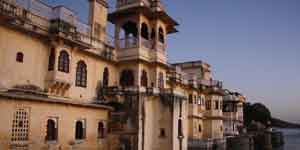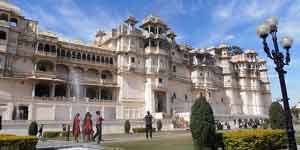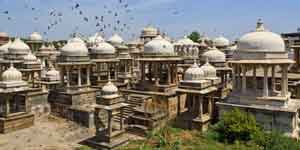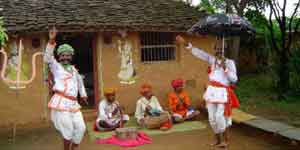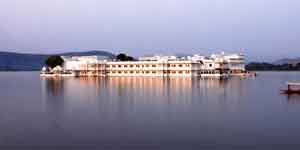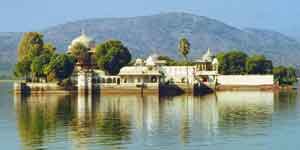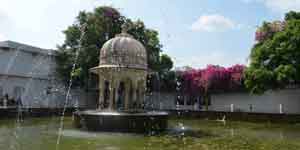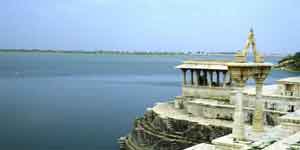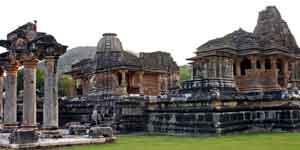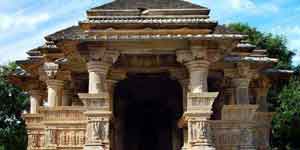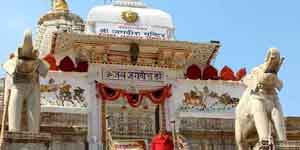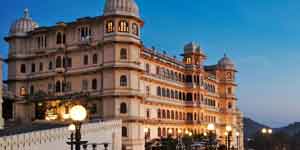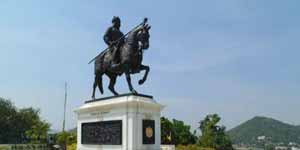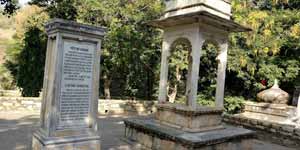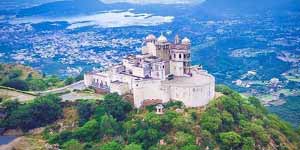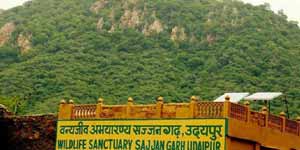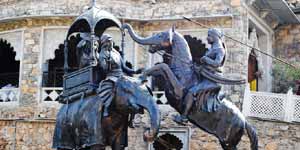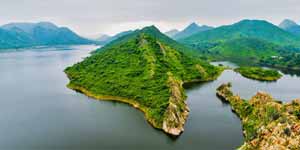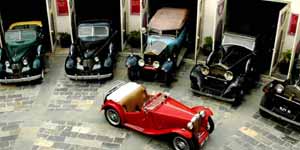

Udaipur Palaces and Monuments are renowned for their artistic architecture. The superb architecture of these monuments boasts about the rich taste of the Royalty. The Royal kings built massive palaces and monuments for their comfort, but today these monuments have become a testimonial of the bygone era. The imperial legacy of the ancestral kings, in the form of these monuments, attracts tourists from all over the globe. The noble Kings were inclined towards beauty and to fulfill their passion, they built lavish structures. Raised in the picturesque surroundings of Udaipur, these monuments are worth spending a few moments with your loved ones.
Many Palaces of the Imperial age have been converted into heritage hotels to offer the same luxurious comfort that used to be the part of the majestic lifestyle. Lake Palace, City Palace and Jag Mandir Palace are the major Palaces of Udaipur, famous for their outstanding architecture. Besides this, Bagore Ki Haveli is another structure that has been preserved to a great extent. The monument of Maharana Pratap Memorial is famous for its life-size statue of Pratap Singh. In this section, we will discuss in detail about these monuments and palaces that are unquestionably tour de force of Udaipur.
One of the major attractions of Udaipur is the City Palace of the Maharanas. It stands astride a low ridge along the shores of the Pichola Lake, an impressive complex of buildings in granite and marble flanked by octagonal corner towers surmounted by cupolas. A blend of Rajput and Mughal styles, the City Palace is a colossal series of buildings which, beyond the edge of the natural bedrock, are carried on huge stone arches and are a continuation of the city walls. The whole exterior is faced in white plaster. The entrance is via the Hari Pol or Great Gate (1600), which contains the royal drums, and on to the Tripolia Gate (1725). Between the two are eight carved Toranas, arches under which the rulers were weighed against gold and silver, which was then distributed to the poor. In the court beyond Tripolia elephant fights were staged. The Ganesh Deori Gate leads to the Rai Angan or royal courtyard (1571), on the east side of which is the Jewel Room. The central pavilion, the Choti Chitra Shali, is enriched with brilliant blue mosaics. The Jagdish Temple (1640) is an imposing building about 400 m from the City Palace.
Two of the most beautiful palaces found among the monuments of Udaipur are the island palaces - Lake Palace and Jag Mandir - located along the banks of the Pichola Lake. Lake Pichola was formed in the 14th century. Fringed with green hills and studded with ghats and gardens, the lake provides a transcendental beauty to Udaipur.
The Lake Palace Hotel (mostly 1754 AD, with recent additions) is simply one of the most beautiful hotel-palaces in the world, like a serene ocean linet perpetually moored in the centre of the lake. The hotel is really a complex of palaces, built from the mid-17th century onwards, interspersed with courts, fountains, trees and gardens. Once the summer residence of the Ranas of Mewar, the former royal banquet rooms are now used as reception suites and bars.
The Jag Mandir, on the southern island, was built in 1551. The domed pavilion or Gul Mahal, which is its greatest landmark, was commenced by Karan Singh (1621-8). It is one of the few examples of Mughal-style architecture in the state. In 1623 Prince Khurram, the future Emperor Shah Jahan, lived here when in revolt against his father, Jahangir, and it is maintained that the pietra dura work on the interior later inspired the detailing of the Taj Mahal. European refugees fleeing the Mutiny were given sanctuary in this palace in 1857. Most of the buildings are of 18th-century origin. Sometimes it is called Jagannath, the Lord of the World, after the temple within the walls of this water-garden palace.
A number of the smaller islands contain pavilions and small palaces. The Mohan Mandir, in the north-cast corner of the lake, was built by Jagat Singh between 1628 and 1652. The road along the east side of the lake leads to Khas Odi, built by Sir Sajjan Singh between 1874 and 1884 as a shooting-box. The lake palaces and Khas Odi are visited by boat.
The Bagore ki Haveli is a very old congenial building located at the waterfront of Lake Pichola at Gangori Ghat. It was built in the 18th century by Amin Chand Badwa. The Haveli has over one hundred rooms, with delicate glass and mirror work in the interiors. There is a fine display of costumes and modern art found here, with some fine exhibits of Mewar painting on the walls of the Queen's Chamber. The building became the property of the State of Mewar after the death of Badwa. It went on to be occupied by Maharana Shakti Singh of Bagore, and it acquired the name of Bagore ki Haveli, house of Bagore. It was the Maharana who built the palace of the three arches here in 1878. The Haveli now holds entertainment programs of traditional song and dance for tourists and visitors.
A number of other beautiful palaces are found strewn all over Udaipur. These exotic palaces are very beautifully decorated, each of them adorned with some unique artistry.
The Sheesh Mahal has inlaid mirrors; the Krishna Vilas, painted miniatures, installed by Raja Bhim Singh in 1805, after his daughter Krishna Kumari chose suicide rather than marriage to a rival prince. The Manak Mahal or Ruby Palace has glass and porcelain; the Moti Mahal or Pearl Palace, mirrors, the Chini-Ki-Chitra Mahal (1711-34) has lovely Dutch and Chinese tiles counterpointed with inlaid mirror work. The Bari Mahal (1699-1711), has a delightful garden as a centrepiece.
The Karan Vilas and Khush Mahal are two other palaces found lying to the west of the Tripola Gate at Udaipur. The Khush Mahal is a pleasure Palace built for European guests sometime in the mid-19th century. Found herein is an extraordinary mixture of European, Rajput and Mughal detailing. Lying to the South is the Shambhu Niwas Palace, to which the Shiv Niwas was later added. The latter is now a hotel. One room has a suite of crystal furniture. The interiors, with mosaic and mirror, tile and glass, enamel and inlaid stones, are a glorious celebration of the power and opulence of the premier Rajput dynasty. North of the Shambhu Niwas is Minto Hall, a large Durbar Hall erected in the late 19th century and named after the Viceroy, Lord Minto.
North of the Pichola Lake a canal leads to Fateh Sagar built in 1678 with an embankment added by Fateh Singh in 1889. The road along its shores is very picturesque. The former British Residency, now a Circuit House, also has lovely gardens. The island garden is called Nehru Park and has a restaurant at its centre.
West of the city Sajjangarh Hill 335 m (1,100 ft) over Fateh Sagar Lake, is crowned by the Monsoon Palace, which commands a panoramic view of the lakes and palaces of the city below.
Moti Magri, overlooking the lake, has an equestrian statue of Maharana Pratap Singh, the Rajput hero. It is a gallant site dedicated to the brave Rajput hero, Maharana Pratap. Known in Hindi as the 'Smarak', the memory was constructed with the initiative of Maharana Bhagwat Singh Mewar. The memorial consists of a life-sized bronze statue of Maharana Pratap, seated on his favourite horse Chetak.
Found at Ahar, lying two miles to the East of the city is the Royal cremation ground. There are elegant cenotaphs of the Rajahs here, interspersed among the trees. The Chatri of Rana Amar Singh I (1621) has a four-faced statue in the centre and panels of bas-reliefs of ranis who chose Sati. There is a small local museum with some excellent exhibits of 10th-century sculpture.
The monuments of Udaipur are known the world over for the grandeur and majesty they exude, a throwback to the Rajput era.
